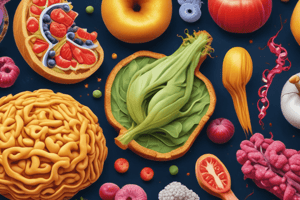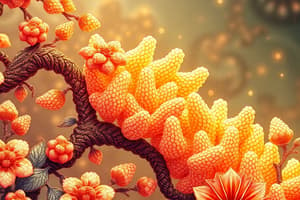Podcast
Questions and Answers
What is the result of oxidation of aldoses with Tollen's reagent?
What is the result of oxidation of aldoses with Tollen's reagent?
- Formation of alditols
- Production of a silver mirror indicating the presence of an aldehyde group (correct)
- Formation of sugar phosphates
- Conversion into lactones
Which reaction involves the interconversion of α and β anomers?
Which reaction involves the interconversion of α and β anomers?
- Glycoside formation
- Oxidation to sugar acids
- Mutarotation (correct)
- Osazone formation
What classifies sugar as reducing sugars?
What classifies sugar as reducing sugars?
- Non-reducing for ketoses
- Ability to oxidize with HNO3
- Presence of an aldehyde group (correct)
- Formation of lactones
What occurs during the exhaustive methylation of carbohydrate compounds?
What occurs during the exhaustive methylation of carbohydrate compounds?
Which statement about the formation of sugar acids is true?
Which statement about the formation of sugar acids is true?
Which of the following is NOT formed from the oxidation of aldoses?
Which of the following is NOT formed from the oxidation of aldoses?
What defines a reducing sugar among monosaccharides?
What defines a reducing sugar among monosaccharides?
What type of linkage is found in sucrose, the common table sugar?
What type of linkage is found in sucrose, the common table sugar?
What is the outcome of glycoside formation?
What is the outcome of glycoside formation?
What is the full name representation of lactose?
What is the full name representation of lactose?
What is the main function of carbohydrates in biological systems?
What is the main function of carbohydrates in biological systems?
Which of the following correctly describes monosaccharides?
Which of the following correctly describes monosaccharides?
Which of the following correctly describes the structure of maltose?
Which of the following correctly describes the structure of maltose?
What structural difference exists between aldoses and ketoses?
What structural difference exists between aldoses and ketoses?
What occurs when HCl gas is introduced to a solution of D-(+)-glucose in methanol?
What occurs when HCl gas is introduced to a solution of D-(+)-glucose in methanol?
What characterizes sulfate groups in sugar molecules?
What characterizes sulfate groups in sugar molecules?
What do D and L configurations in sugars refer to?
What do D and L configurations in sugars refer to?
Which of the following is an example of homopolysaccharide?
Which of the following is an example of homopolysaccharide?
What kind of cyclic forms can fructose form during the cyclization of sugars?
What kind of cyclic forms can fructose form during the cyclization of sugars?
What type of polysaccharide consists of two or more different types of monosaccharides?
What type of polysaccharide consists of two or more different types of monosaccharides?
In the classification of carbohydrates, which of the following represents complex carbohydrates?
In the classification of carbohydrates, which of the following represents complex carbohydrates?
What type of carbohydrate is glucose considered to be?
What type of carbohydrate is glucose considered to be?
Which term describes the acetal form of glucose?
Which term describes the acetal form of glucose?
Epimerism in carbohydrates occurs when:
Epimerism in carbohydrates occurs when:
What type of ring structure does glucose form upon cyclization?
What type of ring structure does glucose form upon cyclization?
Which description accurately differentiates between the alpha and beta anomers of glucose?
Which description accurately differentiates between the alpha and beta anomers of glucose?
Which of the following describes the mechanism of pyranose formation?
Which of the following describes the mechanism of pyranose formation?
What is a unique characteristic of sugar alcohols?
What is a unique characteristic of sugar alcohols?
What change occurs in sugar acids compared to regular sugars?
What change occurs in sugar acids compared to regular sugars?
What is a defining feature of amino sugars?
What is a defining feature of amino sugars?
What role does sialic acid play in glycoproteins?
What role does sialic acid play in glycoproteins?
Which configuration do pyranose sugars commonly assume?
Which configuration do pyranose sugars commonly assume?
What is the primary component of bacterial cell walls that provides mechanical support?
What is the primary component of bacterial cell walls that provides mechanical support?
What characterizes glycosaminoglycans (GAGs)?
What characterizes glycosaminoglycans (GAGs)?
Which of the following is a major component of proteoglycans?
Which of the following is a major component of proteoglycans?
Which type of sugar is typically linked to glycoproteins at the asparagine side chain?
Which type of sugar is typically linked to glycoproteins at the asparagine side chain?
What inhibits the cross-linking of peptidoglycan in bacterial cell walls?
What inhibits the cross-linking of peptidoglycan in bacterial cell walls?
What percentage of carbohydrates by weight can be found in proteoglycans?
What percentage of carbohydrates by weight can be found in proteoglycans?
Which of the following groups is characteristic of glycosaminoglycans?
Which of the following groups is characteristic of glycosaminoglycans?
How are glycoproteins differentiated from other glycoproteins?
How are glycoproteins differentiated from other glycoproteins?
What is the primary role of glycosaminoglycans (GAGs) within the extracellular matrix?
What is the primary role of glycosaminoglycans (GAGs) within the extracellular matrix?
Which of the following best describes the structure of aggrecan?
Which of the following best describes the structure of aggrecan?
What happens when a foreign antigen is introduced to a person who does not naturally have it?
What happens when a foreign antigen is introduced to a person who does not naturally have it?
Which statement accurately describes the function of proteoglycans in the extracellular matrix?
Which statement accurately describes the function of proteoglycans in the extracellular matrix?
What factor influences the selective sieving ability of GAG gels?
What factor influences the selective sieving ability of GAG gels?
Flashcards
Carbohydrates
Carbohydrates
Organic compounds containing carbon, hydrogen, and oxygen, with a general formula Cn(H2O)n, often serving as energy sources or structural components.
Monosaccharides
Monosaccharides
Simple sugars, the fundamental building blocks of carbohydrates.
Aldoses
Aldoses
Monosaccharides containing an aldehyde group at one end.
Ketoses
Ketoses
Signup and view all the flashcards
Stereoisomerism (D vs L)
Stereoisomerism (D vs L)
Signup and view all the flashcards
Epimers
Epimers
Signup and view all the flashcards
Cyclization of Sugars
Cyclization of Sugars
Signup and view all the flashcards
Hemiacetal/Hemiketal Formation
Hemiacetal/Hemiketal Formation
Signup and view all the flashcards
Haworth Projection
Haworth Projection
Signup and view all the flashcards
Pyranose Ring
Pyranose Ring
Signup and view all the flashcards
Chair and Boat Conformations
Chair and Boat Conformations
Signup and view all the flashcards
Sugar Alcohol
Sugar Alcohol
Signup and view all the flashcards
Sugar Acid
Sugar Acid
Signup and view all the flashcards
Deoxy Sugar
Deoxy Sugar
Signup and view all the flashcards
Sialic Acid
Sialic Acid
Signup and view all the flashcards
What are disaccharides?
What are disaccharides?
Signup and view all the flashcards
What is a glycosidic bond?
What is a glycosidic bond?
Signup and view all the flashcards
Sucrose
Sucrose
Signup and view all the flashcards
Lactose
Lactose
Signup and view all the flashcards
Homopoly vs Heteropoly
Homopoly vs Heteropoly
Signup and view all the flashcards
Why are polysaccharides important?
Why are polysaccharides important?
Signup and view all the flashcards
Mutarotation
Mutarotation
Signup and view all the flashcards
Oxidation to Sugar Acids
Oxidation to Sugar Acids
Signup and view all the flashcards
Aldonic Acid
Aldonic Acid
Signup and view all the flashcards
Uronic Acid
Uronic Acid
Signup and view all the flashcards
Aldaric Acid
Aldaric Acid
Signup and view all the flashcards
Reducing Sugar
Reducing Sugar
Signup and view all the flashcards
Osazone Formation
Osazone Formation
Signup and view all the flashcards
Peptidoglycan
Peptidoglycan
Signup and view all the flashcards
Penicillin's Action
Penicillin's Action
Signup and view all the flashcards
What are Glycosaminoglycans?
What are Glycosaminoglycans?
Signup and view all the flashcards
Proteoglycans
Proteoglycans
Signup and view all the flashcards
Glycoproteins
Glycoproteins
Signup and view all the flashcards
Difference between Glycoproteins and Proteoglycans
Difference between Glycoproteins and Proteoglycans
Signup and view all the flashcards
Linkage in Proteoglycans
Linkage in Proteoglycans
Signup and view all the flashcards
Proteoglycan Functions
Proteoglycan Functions
Signup and view all the flashcards
What are GAGs?
What are GAGs?
Signup and view all the flashcards
Aggrecan
Aggrecan
Signup and view all the flashcards
Decorin
Decorin
Signup and view all the flashcards
Blood Group Antigens
Blood Group Antigens
Signup and view all the flashcards
Study Notes
Carbohydrates
- Carbohydrates are compounds containing carbon, hydrogen, and oxygen. They have the general formula Cn(H2O)n.
- They are major components of life, making up most organic matter.
- Functions include energy storage, metabolic intermediates, and structural framework of RNA and DNA (in certain organisms).
- Classified into simple and complex carbohydrates.
Monosaccharides
- Simplest carbohydrates
- Have aldehyde or ketone groups with multiple hydroxyl groups.
- Examples include glucose, fructose, and galactose.
- Classified into aldoses (aldehyde group) and ketoses (ketone group).
- Stereoisomers (D and L forms): D & L designation depends on the chirality around the carbon furthest from the aldehyde or ketone.
- Epimers are stereoisomers that differ at only one chiral carbon.
- Nomenclature based on number of carbons (triose, tetrose, pentose, hexose) and the presence of aldehyde or ketone group.
Disaccharides and Polysaccharides
- Disaccharides are formed by combining two monosaccharides via a glycosidic bond.
- Examples include sucrose (glucose + fructose), lactose (galactose + glucose), and maltose (glucose + glucose).
- Polysaccharides are formed by linking many monosaccharides through glycosidic bonds.
- Examples include starch (amylose and amylopectin), glycogen, and cellulose.
Cyclization of Sugars
- Monosaccharides can cyclize to form ring structures (hemiacetals or hemiketals).
- This is crucial for their stability and function.
- Anomers are different ring forms distinguished by the position of the hydroxyl group on the anomeric carbon.
Sugar Derivatives
- Sugar alcohols lack an aldehyde or ketone and are formed by reduction reactions.
- Sugar acids are formed by oxidation reactions.
- Deoxysugars are formed by removal of one or more hydroxyl groups.
- Amino sugars are characterized by the presence of an amino group.
Reactions of Monosaccharides
- Mutarotation involves the interconversion of α and β anomers in solution.
- Oxidation reactions produce sugar acids.
- Reduction reactions form sugar alcohols.
- Osazone formation is a characteristic reaction for glucose.
Disaccharides
- Disaccharides are formed by linking two monosaccharides through glycosidic bonds.
- Examples include sucrose, lactose, and maltose.
- Glycosidic bonds connect the anomeric carbon of one monosaccharide to another.
Polysaccharides
- Polysaccharides are long chains of monosaccharides linked by glycosidic bonds.
- Examples include starch, glycogen, and cellulose.
- Starch and glycogen are storage forms of glucose; cellulose provides structural support.
Others
- Glycoproteins and proteoglycans are proteins with attached carbohydrates.
- Structural and functional roles in cells and organisms.
- Include peptidoglycan, a component of bacterial cell walls, and glycosaminoglycans (GAGs), components of ECM and proteoglycans, playing a crucial role in structural integrity and cell signaling.
- Blood group antigens are oligosaccharides found on cell surfaces, determining blood type and playing a role in immune responses.
Studying That Suits You
Use AI to generate personalized quizzes and flashcards to suit your learning preferences.




